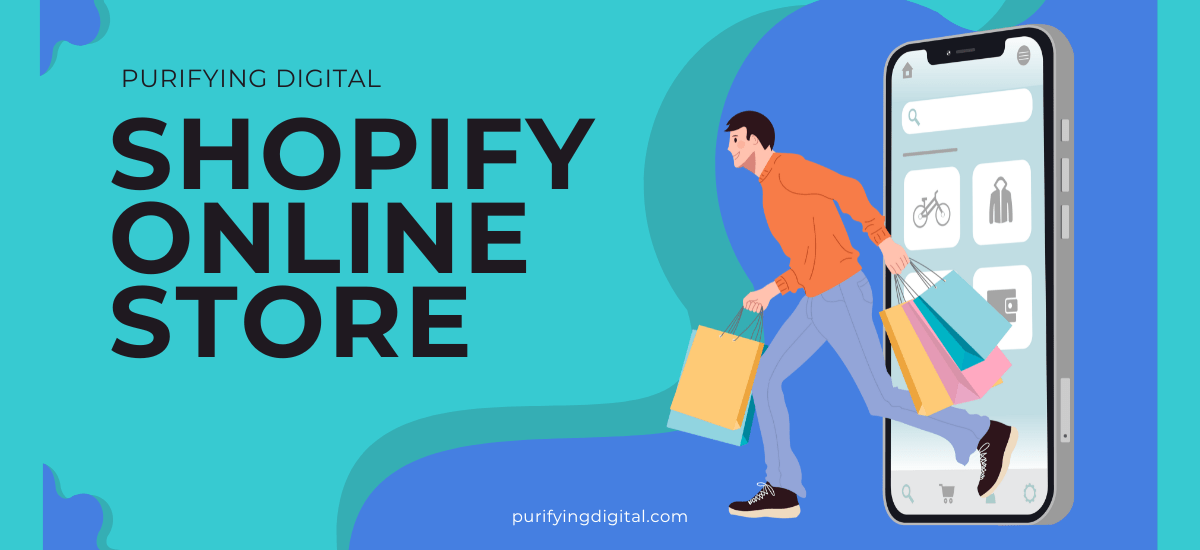Shopify is a platform on which you can build your eCommerce store at a very minimal cost. It provides an easy-go solution for adding products to online payments, securing shopping carts, and managing shipping and inventory. This article will help you to build your online shopping store.
Table of Contents
ToggleStep 1: Sign Up for Shopify
You can sign up for a free account on Shopify with a free trial for 3 days; no credit card is required, and the first month is just for 20 rupees. Shopify offers a 25% discount on yearly payments and four types of plans.
- Basic Plan: Ideal for individuals or startups.
- Shopify Plan: Suitable for small team-sized businesses.
- Advanced Plan: As your business grows, it suits large companies.
- Plus Plan: For large Enterprise and complex businesses.
Pick the most suitable one for your requirements.
Step 2: Set Up Your Store’s Domain
Book a new professional domain name for your online store.
Use Shopify’s Default Domain: Shopify offers a free domain but needs to be more professional.
Purchase a Custom Domain: To get a professional domain, purchase from Shopify or any third-party platforms like Hostinger or Godaddy. A professional domain name is recommended for severe businesses.
Step 3: Select Shopify Theme
Shopify offers various themes that you can customize to fit your products.
Go to “Shopify admin > Online Store > Themes.”
Go to Shopify Theme Store and select unique themes for your products.
Click on “Customize” to start editing.
Tips for Customizing Your Theme
- First, select a suitable Theme according to our product or brand.
- Use the theme editor to make a visual change on your website and customize the header, footer, color and fonts according to your style.
- Use the mobile responsive theme and customize the Shopify sections and blocks to build a dynamic page.
- Integrate high-quality images and videos for professional looks and update your product pages with titles, descriptions and price details.
Step 4: Add Products to Your Store
To add a product to your Shopify store, follow the steps given below:
1. In your Shopify admin, go to your product tab.
2. Click on Add product
3. Write a unique product title and description, and show reviews.
4. Add HD-quality images and videos for your product. Include multiple images from different angles.
5. Set a competitive price for your product; you can show the discounts and offers with price as Shopify allows you to show and compare prices.
6. Enable inventory tracking to keep an eye on your stock.
Step 5: Set Up Payment Methods
To receive a payment from a customer, you need to set up a payment on the Shopify store.
Shopify supports various payment methods:
Shopify Payments: Shopify itself provides a payment method without any additional transaction fees.
Credit Card Processors: If you want to receive payment via Credit Card, you can integrate it easily on Shopify.
PayPal: PayPal is widely used for international transactions and is the most trusted medium for payment transfer.
To set up your preferred method, you need to go to Settings > Payments in your Shopify admin, then add a payment method according to your choice or add multiple options as per your customer preferences.
Step 6: Configure Shipping and Tax Settings
Setting tax rates and shipping is challenging, but Shopify makes this process easy. Shopify allows you to set the shipping and taxes on your website easily.
Setting Up Shipping:
Go to “Settings” > “Shipping and Delivery“.
Define your shipping zones (e.g., domestic, international).
Set shipping rates on product weight, price, or location.
Integrate with apps for real-time tracking.
Configure Taxes:
Shopify calculates taxes automatically based on your location. Go to “Settings” > “Taxes” and enable automatic tax calculation.
Step 7: Optimize Your Store for SEO
To gain organic traffic, you need to improve your SEO, which finally converts into customers; follow these best practices:
Title Tags and Meta Descriptions: Keep your title and description unique. Also, use primary keywords in your meta title and description.
URL Structure: Keep your URL structure short, keyword-rich and concise.
Structure your content: Organise your content by using heading tags(H1, H2, H3) and make your content well-researched, relevant and unique.
Optimize Image: Use alt text for images and compress them to load faster.
Blog Content: Create value-added content for your website visitors and build up the topical authority related to your product.
Step 8: Test Your Store Before Launching
Before launching your Shopify store, ensure you have tested the checkout process and that the payment gateways are working correctly.
Follow the Testing Checklist of the Shopify store:
- Make sure your store is mobile-responsive.
- Check by adding and removing products from the cart.
- Check the payment methods are working correctly.
- Add Shipping and taxes for random products and see whether all aspects work as expected.
- Check for any broken links, 404 error pages, or grammatical or spelling mistakes.
Step 9: Launch Your Shopify Store
Once the testing process is over and everything is working fine, you can go to “Online Store” > “Preferences” and turn off password protection. Now, your store is live and available to the public.
Step 10: Promote Your Store
Once you are live, you need to promote your store online. Here are a few things you need to do to promote your store:
SEO: Optimizing your store with fresh content and relevant keywords helps you to gain ranking and bring visitors to your website.
Social media marketing: Promote your products on Facebook, Instagram, Pinterest, Telegram, and other social media platforms.
Paid Advertising: You can use various platforms for paid advertising, like Google Shopping Feed, Google Ads, Facebook Ads, LinkedIn Ads, YouTube Ads, etc.Content marketing: Plan your content marketing in a way that builds topical authority on your product niche and shares your content with your audience on social media platforms
Conclusion:
Follow this step-by-step guide to launch your Shopify store. Use the Shopify themes and apps to build your store and make your products available online to your customers. To become a more professional and profitable online store, you need an expert service like Purifying Digital, which helps you build a professional online store.
So, turn your eCommerce dreams into reality with Purifying Digital and grow your business today!


